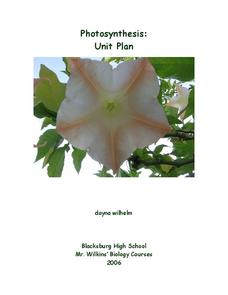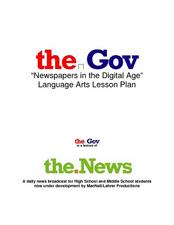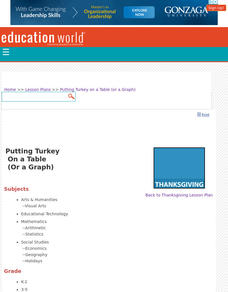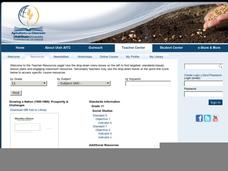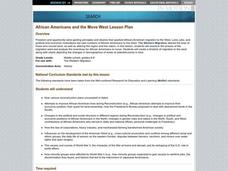Curated OER
Photosynthesis
We all know photosynthesis happens, but why should we care? Here is a unit that covers everything young scholars need to know about photosynthesis. Hands-on activities, assessments, and lectures guide pupils though the physiology of a...
MENSA Education & Research Foundation
Connecting Africa: A Project-Based Learning Adventure
Mission Possible: Your task is to design a new highway route from Tunis, Tunisia to Cape Town, South Africa. If you accept the challenge, you must create a small map of the route that has already been rejected, a rationale for rejection...
Curated OER
Today's World
While not an exhaustive review of globalization and trade, this overview of the inter-related nature of the economy would be a good tool to use in the classroom. This resource could be used to begin a discussion on the various topics...
Curated OER
The Great Depression and New Deal
Elementary pupils are introduced to the Great Depression as a critical period of hardship in United States history. They engage in collaborative assignments researching the Dust Bowl, the New Deal, US presidents, and presidential libraries.
NET Foundation for Television
1850-1874 African American Settlers
Go West, young man! Scholars investigate the impact of African American settlers moving to the Nebraska territory, following the passage of the Kansas-Nebraska Act in the mid 1800s. Using primary sources, timelines, maps, and...
Curated OER
The Appliance Explosion
Students explain why the number of appliances used today differs greatly from the number used previously. They construct a bar graph to show changes in appliance use over a period of time. They also list appliances that could be eliminated.
Pittsburgh Ballet Theatre
The Nutcracker Teacher Resource Guide
Clara becomes Marie, The Mouse King becomes a rat, and the Shadyside section of Pittsburgh becomes the setting for a modern interpretation of Tchaikovsky's famous ballet. Intended as a resource guide for a 2012 performance, the...
Curated OER
Newspapers in the Digital Age
Is journalism more or less reliable with the influx of Internet sources? Learners investigate the issues of freedom of speech, journalistic ethics, and social responsibility in the age of Twitter and Facebook. After examining the...
NET Foundation for Television
1850-1874 Native Americans and Settlers
Did Western settlers receiving free land from the Homestead Act realize it wasn't really free at all? Scholars investigate the impact Western expansion had on Native American culture in the mid-1800s. They use documents, timelines, and...
Education World
Putting Turkey on a Table (or a Graph)
Grateful learners put turkey on a table (or a graph)! Through a creative project they show statistical information about turkey population, production, and consumption. A great Thanksgiving lesson that can be applied at any time to the...
Agriculture in the Classroom
Growing a Nation (1950-1969): Prosperity & Challenges: The Story of American Agriculture
A wonderful lesson on the development and impact of mechanized farming! History or agriculture classes learn the historical background of the United States' food production by creating a pamphlet with information on the cause and effect...
Curated OER
African Americans and the Move West
Middle schoolers examine the phases of westward migration in the United States during the 19th century focusing on the incentives that led many African Americans to make the move.
Curated OER
Maps of Indian Territory, the Dawes Act, and Will Rogers' Enrollment Case File
Learners, in groups, analyze one map at a time, first the 1885 map, then the 1891 map. After they have completed the analysis sheets, they compare the two maps and answer questions imbedded in the plan.
Curated OER
How Things Fly
Students observe photographs of selected twentieth-century aircraft at the National Air and Space Museum and note differences in the design of aircraft wings, fuselages, and engines.
Curated OER
Youth in the Economy
Young scholars discuss and identify their roles within the economy. In groups, they identify the similiarities and differences among different groups of people and describe the types of roles within an economy. They have a partner...
Curated OER
Fort at No. 4 History
Learners examine the history of Fort No. 4 in New Hampshire before visiting the site. They identify key events and people that occured at the fort as well. They complete questions and teach them to their group.
Curated OER
Colonization and Emigration
Students explore emigrants deciding to leave the United States and the events that lead to their decisions.
Curated OER
Haitian Immigration: Twentieth Century
Young scholars read a narrative about the culture, heritage and history of Haiti including the contributions of Haitian immigrants in the U.S. They conduct further research on Haitian culture and prepare a presentation for the class.
Curated OER
The Rocky Shore
Pupils compare a realistic landscape painting with a photograph of the same place.
Curated OER
Letters from the Japanese American Internment
Young scholars make deductions about life in an internment camp by reading and comparing letters written to Clara Breed. Along the way, they consider the advantages of looking at a historical event from the multiple points of view of...
Curated OER
What's In Your Grocery Bag?
Students explore the global implications of consumer decisions when purchasing groceries. They examine labels of food products and discuss the wording on the labels. They calculate food miles of how far each ingredient in foods has...
Curated OER
Sustainable Dining
Students evaluate the how their product choices impact the environment. They discuss the concept of sustainability in agriculture. Students give reasons for buying sustainable food products. A cost-benefit analysis concerning sustainable...
Curated OER
Comparison Food Shopping: Buying Groceries for Two People for One Week
Twelfth graders investigate how to develop a simple food budget for two using newpaper ads, the basic four food groups, and calorie counts.
Curated OER
In the Right Mode
Sixth graders practice determining mean, median, mode, and range using individual mileage logs. They convert miles to kilometers and graph their results.


